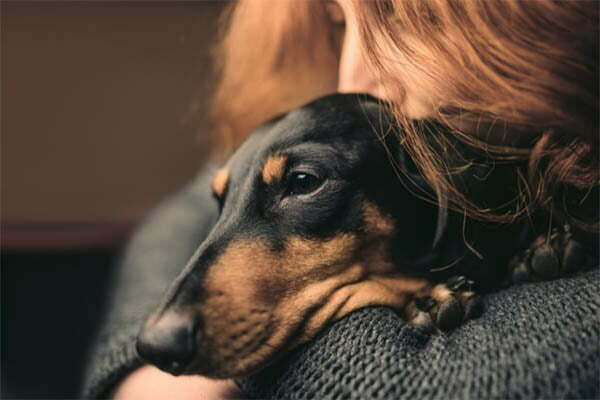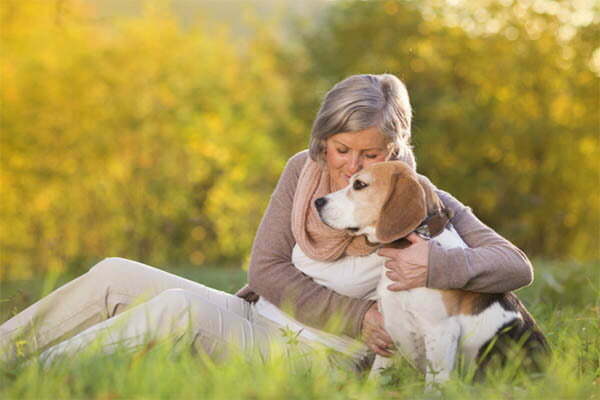Every dog owner has stumbled over their pet, stepped on their paw, or shouted at them at some point. It is often followed by us profusely apologizing, but how do we know that this is getting through to them?

Do they understand when we say sorry? It can be hard to deal with the guilt of upsetting them, but there’s no reason that you can’t fix it.
We have rounded up the best way to apologize to your dog in 5 steps. This simple and effective method ensures that your dog understands you are sorry.
It will also help to strengthen the bond between you and your dog with love and affection.
Do dogs know when you’re sorry?
A qualified animal behaviorist, Emma Griffin, suggests that dogs do not have the necessary range of emotions for in-depth cognitive processing.
She goes on to say that we can assume dogs have an ability to pick up on social cues and behavioral shifts. This means that they likely have a basic understanding of what is happening around them.
Apologizing to dogs centers around reminding them of your love, affection, and support. You need to reassure them that you are still their human and will look after them.
Can dogs forgive you?
The true answer to this question is that no one knows. Forgiveness is a human emotion, and we cannot assume that we can project this onto other species.
Regardless, it cannot hurt to say that you are sorry if you believe that you have upset your dog.
It will make you feel better, and even if your dog cannot fully comprehend your apology, they will understand you are giving them love.
Some dog behavioral experts, such as Jeffrey Masson, believe that dogs can forgive you. The way he suggests they demonstrate this behavior is by licking your hand.
It is safe to say that dogs do not hold grudges. There is very little you could do that they wouldn’t forgive in a day or so.
This is likely due to their reduced levels of emotional intelligence, although it doesn’t mean that they don’t get upset. Many dogs have an emotional trigger response immediately after being hurt, which then fades within minutes.
In essence, we will never truly know if dogs can forgive us or not. That being said, we can assume that they understand when you feel remorseful and apologetic.
Their quick return to normality following an incident suggests that they can forgive you. This could just be us drawing conclusions though.
How do you apologize to your dog?
It is important to apologize to your dog if you hurt them. Even if you are not convinced that they understand you, it gives them a level of reassurance. Imagine if one of your parents hurt you and then pretended as if nothing happened.
You should take the time to acknowledge that you have made a mistake and reassure them that you still love them. Failing to do this could lead to feelings of loneliness and being unloved.
The steps listed below are some general tips for apologizing to dogs. Like humans, every dog is different. Pay attention to the behavioural cues that your dog is giving you and adapt your approach accordingly.
Some dogs respond best to hugs, others to walks. The most important thing is that they know you care and are focused on them.
Step 1: Respect their space
If you accidentally hurt your dog, your first instinct is to hug them and apologize profusely. This is not necessarily the best idea.
If they are hurt badly and then you get into their personal space, they may perceive this action as a threat.
They may snap at you or lash out as a knee-jerk reaction. Instead, you should allow them a little bit of space to deal with their pain. Drop back a couple of paces to show that you are not an intimidating presence, and speak softly to them.
It is also a good idea to avoid making eye contact with your dog. While it is considered a sign of respect in humans, to animals, it means something different.
Sustained eye contact is a sign of dominance and can be perceived as a threat in the animal world. When you are trying to calm your dog down, this is not a wise step to take.
Many dogs will prefer you to offer the side of your body to them instead of walking directly at them. Similar to eye contact, walking head-on directly at an animal can be seen as threatening and challenging.
Exposing your side to them gives you a good balance where you do not seem scary, but you are also not completely turned away from your dog.
It is a good idea to wait and allow your dog to approach you. If they are scared, then the last thing you want to do is push them away by forcing yourself on them.
Wait patiently for the dog to approach you, you can drop a few treats at this point to congratulate them for being brave.
Step 2: Use a soothing and calming voice
There is nothing that elevates a stressful situation faster than speaking in an aggressive or harsh tone of voice. Dogs are reactionary animals and will respond with a similar level of emotion as that which you are directing at them.
Do not shout at your dog, no matter how stressed you are. This will do nothing except elevate the situation and stress your dog out further.
There is a strong likelihood that yelling at your dog will cause them to behave badly and could potentially have negative repercussions on their behavior down the line.
When you notice that they are hurting, you should try and talk with a very calm tone of voice. Dogs cannot understand the specific words that you say, but they can clearly pick up on the tone.
This means that the tone is much more important to get right than the words. This should be your primary focus. It is a good idea to use a tone similar to that which you use when reinforcing good behavior.
Speak softly and quietly to them, using a happy tone. Lower the register of your voice slightly and ensure you get down onto their level.
We recommend speaking slowly, as this adds to the calming effect. Be patient with your apology, as with humans, it will take some time to earn your dog’s trust back.
Do not talk too much. This can be as overwhelming for your dog as talking loudly. Once you have said a few gentle words to them, quieten down and gauge your dog’s response.
Add to the sense of calm by gently stroking your dog as you apologize. Dogs are very tactile animals and this will help to emphasize the serene atmosphere you are trying to create.
Step 3: Don’t use treats
Treats are used as a reward for good behavior and act as a kind of positive reinforcement. They should be used as training tools only.
You may be tempted to feed your dog a treat by way of apology, but this gives them very confusing and mixed messages.
When apologizing, you are not congratulating your dog on doing anything. Instead, you are placating them to avoid dealing with the issue correctly. We do not advise giving your dog treats of any kind while you are apologizing.
Step 4: Don’t rush
Moving quickly and flamboyantly can cause your dog to become stressed. When they are already in a state of heightened anxiety, this can tip them over the edge and make them become panicked.
We recommend moving slowly. If you need to move, try and sigh gently or give some other audible cue that you are about to change position. This will help to keep your dog calm and prevent them from feeling overwhelmed.
You should not rush to console your dog if they appear scared or angry. The apology should come when the environment is calm and controlled.
Give them a minute to calm down but ensure you are talking calmly to them at this time. That being said, you should apologize close to the fact.
If you hurt your dog in the morning, do not wait until the evening to apologize. It should be done within 20 minutes of the incident. This helps them to connect the apology to the action, allowing it all to make sense.
Step 5: Give them love and affection

Love, affection, and tummy rubs are the best ways to communicate with your dog. This is the language that they understand and will respond best to. Even if none of the rest of your apology makes sense to them, they will understand you still love them.
This acts as a kind of positive reinforcement and proves that you care for your dog. If you are relaxed in demeanour, your dog will be too.
Similarly to how you would treat a child, you can grab the hurt area of their body. Say that you have stepped on their paw.
Once they approach you and you have calmly begun to reassure them, grab the injured paw. Very gently stroke the injury while apologizing. Some dog owners swear that this helps the dog to connect the apology to the injury.
If the injury is not too severe, you can attempt to play with them. Many dogs will apologize to one another by playing together.
Grab your dog’s favorite toy and see how they react. Playing together is a great bonding experience and will help to strengthen the connection between you and your pet.
This will also put them in a very positive state of mind and will make them much happier overall.
Give your dog lots of cuddles and kisses. Stroke the areas that you know they enjoy the most, giving them slow and gentle scratches.
Take your time and give your dog your full attention. This is the best way to prove to your dog that you are remorseful. Pay close attention to them for the next few days. They will love this additional attention and will feel spoiled.
